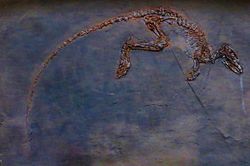Our website is made possible by displaying online advertisements to our visitors.
Please consider supporting us by disabling your ad blocker.
Leptictidium
| Leptictidium Temporal range: Early to Late Eocene,
| |
|---|---|

| |
| Fossil L. auderiense skeleton, Muséum national d'histoire naturelle | |
| Scientific classification | |
| Domain: | Eukaryota |
| Kingdom: | Animalia |
| Phylum: | Chordata |
| Class: | Mammalia |
| Order: | †Leptictida |
| Family: | †Pseudorhyncocyonidae |
| Genus: | †Leptictidium Tobien, 1962 |
| Type species | |
| †Leptictidium auderiense Tobien, 1962
| |
| Species | |
| |
Leptictidium is an extinct genus of small mammals that were likely bipedal. Comprising eight species, they resembled today's bilbies, bandicoots, and elephant shrews, and occupied a similar niche. They are especially interesting for their combination of characteristics typical of primitive eutherians with highly specialized adaptations, such as powerful hind legs and a long tail which aided in locomotion. They were omnivorous, their diet a combination of insects, lizards, frogs, and small mammals. Leptictidium and other leptictids are not placentals, but are non-placental eutherians, although they are closely related to placental eutherians. They appeared in the Lower Eocene, a time of warm temperatures and high humidity, roughly fifty million years ago. Although they were widespread throughout Europe, they became extinct around thirty-five million years ago with no descendants,[1] as they were adapted to live in forest ecosystems and were unable to adapt to the open plains of the Oligocene.
- ^ McKenna, M. C; S. K. Bell (1997). Classification of Mammals Above the Species Level. Columbia University Press. ISBN 0-231-11012-X.
Previous Page Next Page


